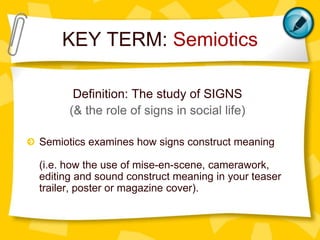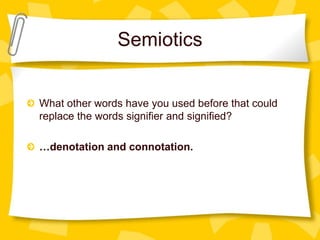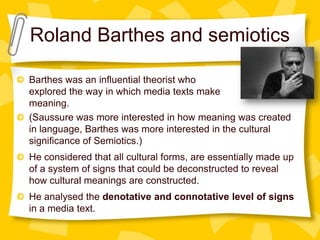Media language 2014
- 1. Media Language The way in which a text is constructed to create meaning for a reader or viewer of the text Some of the content is adapted from Chandler (2005) http://www.aber.ac.uk/media/Documents/S4B/sem02.html
- 2. What does this connote?
- 4. Now what does it connote?
- 5. For the exam you need to be able to: Write a coherent analysis of the media language in your teaser trailer including: Reference to theory - Semiotics Examples of the denotative and connotative levels of meaning within your teaser trailer. Appropriate use of key terms (e.g. denotation and connotation, signifiers and signified, codes and conventions).
- 6. KEY TERM: Semiotics Definition: The study of SIGNS (& the role of signs in social life) Semiotics examines how signs construct meaning (i.e. how the use of mise-en-scene, camerawork, editing and sound construct meaning in your teaser trailer, poster or magazine cover).
- 7. Semiotics – The Study of Signs Saussure (a founder of semiotics) summarised it in the following equation: The Sign = signifier + signified the form which the sign takes the concept it represents So meaning is not fixed, the sign can be different depending on the signified, i.e. the reader’s interpretation of the signifier.
- 8. Semiotics What other words have you used before that could replace the words signifier and signified? …denotation and connotation.
- 9. How to read the signs and signifiers within a Media Text All media texts have 2 layers of meaning: DENOTATIVE LEVEL: What we actually see/hear CONNOTATIVE LEVEL: What you associate with this image
- 10. Roland Barthes and semiotics Barthes was an influential theorist who explored the way in which media texts make meaning. (Saussure was more interested in how meaning was created in language, Barthes was more interested in the cultural significance of Semiotics.) He considered that all cultural forms, are essentially made up of a system of signs that could be deconstructed to reveal how cultural meanings are constructed. He analysed the denotative and connotative level of signs in a media text.
- 11. This image denotes a tropical island The image connotes peace, tranquility paradise, holiday, summer to some readers. …but think about the film ‘Castaway’, the victims of the Bali bombings or the recent tsunami - in this case the image may connote isolation, fear or even death It is important to note that images have different connotations depending on the reader of the image/text
- 12. Denotation & Connotation within a Media Text – A Movie Poster The Mission Impossible Poster denotes a MATCH and a GLOBE OF THE WORLD What are the connotations of a) The match? b) The globe? What are they communicating to an audience? Why?
- 13. Semiotics – codes and conventions We interpret things as signs largely unconsciously by relating them to familiar systems of codes and conventions (e.g. genre conventions, cultural conventions, etc.). e.g. low key lighting which casts dark shadows in a film scene can symbolise mystery or sinister characters.
- 14. But it all depends on context! What made the shadows mysterious or even sinister in the last slide? What different meanings are created in the images on this slide?
- 15. Shadows as symbolic codes Shadows are not mysterious in themselves. I am tapping into cultural ideas that connect darkness with the unknown or hidden. Also, expectations based on our understanding of thriller/horror film codes and conventions, which associate low key lighting and dark shadows in a scene with mystery or sinister characters.
- 16. Semiotics Signs can be polysemic (have many possible meanings) Why do viewers interpret certain meanings over others? – Context is important – how signs work in combination will lead us towards particular readings over others. – Dominant cultural ideas will lead us towards certain interpretations over others. – We understand the conventions of particular media forms.
- 17. Examples Textual analysis of media language reveals how the following adverts are constructed to create certain meanings in relation to their product.
- 18. SIGNIFIER: Water/Ocean Wave SIGNIFIES: Wild, Stormy, Natural, Earthly SIGNIFIER: Facial Expression/Body Language SIGNIFIES: Ecstatic, pleasure lost in ecstacy, laid back, inviting SIGNIFIER: Mans Naked Torso SIGNIFIES: Natural, angelic, pure, toned, ideal, masculine, adonis SIGNIFIER: Words ‘Cool Water’ SIGNIFIES: Refreshing, different, SIGNIFIER: Droplets on Bottle SIGNIFIES: Cool, chilled appearance, almost drinkable SIGNIFIER: Calligraphy Style Font SIGNIFIES: Classic, timeless, expensive tastes
- 19. SIGNIFIER: Blonde Hair Signifies: Ideal Woman, Inn ocence, Loo ks ‘gold’ SIGNIFIER: Perfume Bottle Signifies: Looks Jewellike, Buried Treasure SIGNIFIER: Jewellery Signifies: Extravagance, Excess, Glamour, Decedance SIGNIFIER: Word ‘Love’ Signifies: Passion, Excitement, Lust SIGNIFIER: Font Signifies: Dior Logo, Brand Name, Designer SIGNIFIER: Colour Gold Signifies: Luxury, Riches, Expense, Success, Shimmering
- 20. Over to you Analyse your own media product Annotate it with denotations and connotations (or signifiers and signified) In your connotations, try to link to genre, narrative, audience and representation where relevant.
- 21. Roland Barthes and semiotics Barthes argues that the organisation of signs encodes particular messages and ideologies and that these ideologies can be revealed as constructed through textual analysis. He described these constructed messages and ideologies as myths.
- 22. Over to you Go back to your analysis. Summarise any overall messages it connotes or cultural myths it reinforces.
- 23. For those of you who want to really stretch your academic muscles… ‘Semiotics is important because it can help us not to take 'reality' for granted as something having a purely objective existence which is independent of human interpretation. It teaches us that reality is a system of signs. Studying semiotics can assist us to become more aware of reality as a construction and of the roles played by ourselves and others in constructing it …Meaning is not 'transmitted' to us - we actively create it according to a complex interplay of codes or conventions of which we are normally unaware. Becoming aware of such codes is both inherently fascinating and intellectually empowering… In defining realities, signs serve ideological functions. Deconstructing and contesting the realities of signs can reveal whose realities are privileged and whose are suppressed. The study of signs is the study of the construction and maintenance of reality. To decline such a study is to leave to others the control of the world of meanings which we inhabit.’ Daniel Chandler (2005)






















